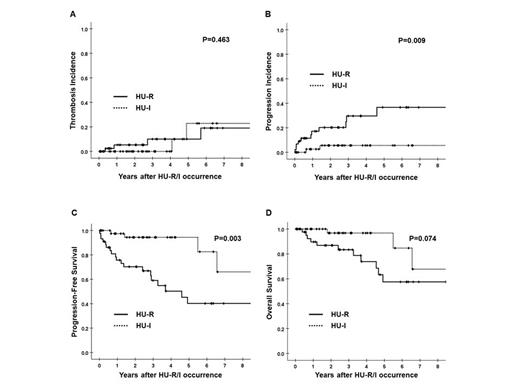Previous retrospective studies have revealed that a substantial portion of PV patients experience resistance to hydroxyurea (HU-R) and intolerance to HU (HU-I). Currently, the therapeutic options for both groups of patients do not differ, and most clinical trials investigating second-line therapies have enrolled patients with HU-R or HU-I without considering potential clinical distinctions between the two groups. Direct comparisons between patients with HU resistance and HU intolerance have not been conducted, and prognostic factors related to clinical outcomes, such as thrombosis, bleeding, disease progression, and survival, remain unclear for patients experiencing HU resistance or intolerance.
A total of 90 patients with HU-R/I were retrospectively anlyzed in this study. Among them, 44 and 46 patients fulfilled the ELN criteria defining resistance or intolerance to HU, respectively. Patients with HU-R were older at the time of diagnosis of PV (66.7 ± 13.2 years, vs. 59.8 ±11.2 years in the HU-I group, P = 0.016), had longer times to developing HU-R/I, and thus, were older at the time of HU-R/I development compared with those with HU-I. The majority of the study patients continued HU treatment with dose modification or intermittent discontinuation with anagrelide added to control platelet counts until disease progression or death because of limited second-line treatment options during the observed period.
The cumulative incidence of thrombosis after 7 years of HU-R/I was 21.4%, and the incidence of disease progression was 22.5%. Comparing the HU-R and HU-I groups, the HU-R group had a significantly higher rate of disease progression (36.7% vs. 0.56%, P = 0.009), while there was no significant difference in thrombosis incidence (19.0% vs. 22.9%, P = 0.463). The type of thrombosis did not differ between the two groups (P = 0.628). Multivariate analysis revealed that HU-R was an independent prognostic factor for progression-free survival (hazard ratio = 5.57, 95% CI: 1.22 - 25.54, P = 0.027).
The patients in the HU-R group had significantly lower PFS (40.2% vs. 66.1% in the HU- I group, P < 0.01). They also showed a trend toward lower TFS (51.0% vs. 62.1% in the HU-I group; P = 0.055) and lower OS (57.5% vs. 67.7% in the HU-I group; P = 0.060) compared to patients with HU-I. The mortality at seven years was 42.5% in the HU-R group and 32.3% in the HU-I group (P = 0.06). Higher LDH levels, multiple cardiovascular risk factors, and prior thrombosis were identified as unfavorable predictors of overall survival.
These findings suggest that HU-resistant patients have a higher risk of hematological transformation but a comparable risk of thrombosis to HU-intolerant patients. These distinctions should guide decisions on second-line treatment options and clinical trials involving these patients.
Disclosures
Hong:Bridgebio Therapeutics: Consultancy; Bristol Myers Squibb Korea: Consultancy, Honoraria; Novartis Korea: Honoraria.


This feature is available to Subscribers Only
Sign In or Create an Account Close Modal